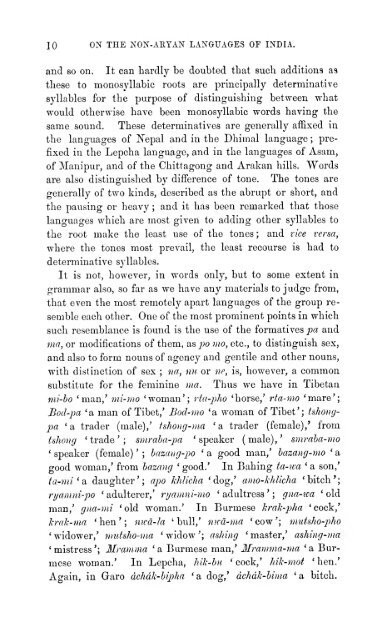You also want an ePaper? Increase the reach of your titles
YUMPU automatically turns print PDFs into web optimized ePapers that Google loves.
10<br />
ON THE NON-ARYAN LANGUAGES OF INDIA.<br />
and 80 on. It can hardly be doubted that sucb additions as<br />
<strong>the</strong>se to monosyllabic roots are principally determinative<br />
syllables for <strong>the</strong> purpose <strong>of</strong> distinguishing between what<br />
would o<strong>the</strong>rwise have been monosyllabic words having <strong>the</strong><br />
same sound. These determinatives are generally affixed in<br />
<strong>the</strong> <strong>languages</strong> <strong>of</strong> Nepal and in <strong>the</strong> Dhimal language ; prefixed<br />
in <strong>the</strong> Lepcha language, and in <strong>the</strong> <strong>languages</strong> <strong>of</strong> Asam,<br />
<strong>of</strong> Manipur, and <strong>of</strong> <strong>the</strong> Chittagong and Arakan hills. Words<br />
are also distinguished by difference <strong>of</strong> tone. The tones are<br />
generally <strong>of</strong> two kinds, described as <strong>the</strong> abrupt or short, and<br />
<strong>the</strong> pausing or heavy ; and it has been remarked that those<br />
<strong>languages</strong> which are most given to adding o<strong>the</strong>r syllables to<br />
<strong>the</strong> root make <strong>the</strong> least use <strong>of</strong> <strong>the</strong> tones ; and vice versa,<br />
where <strong>the</strong> tones most prevail, <strong>the</strong> least recourse is had to<br />
determinative syllables.<br />
It is not, however, in words only, but to some extent in<br />
grammar also, so far as we have any materials to judge from,<br />
that even <strong>the</strong> most remotely apart <strong>languages</strong> <strong>of</strong> <strong>the</strong> group re-<br />
semble each o<strong>the</strong>r. <strong>On</strong>e <strong>of</strong> <strong>the</strong> most prominent points in which<br />
such resemblance is found is <strong>the</strong> use <strong>of</strong> <strong>the</strong> formatives pa and<br />
ma, or modifications <strong>of</strong> <strong>the</strong>m, as jjo ino, etc., to distinguish sex,<br />
and also to form nouns <strong>of</strong> agency and gentile and o<strong>the</strong>r nouns,<br />
with distinction <strong>of</strong> sex ; na, nu or ne, is, however, a common<br />
substitute for <strong>the</strong> feminine ma. Thus we have in Tibetan<br />
mi-ho 'man,' mi-mo 'woman'; rta-pho 'horse,' rta-mo 'mare';<br />
Bod-2)a 'a man <strong>of</strong> Tibet,' Bod-mo 'a woman <strong>of</strong> Tibet'; tshongpa<br />
*a trader (male),' ishong-ma 'a trader (female),' from<br />
tshong 'trade*; smraba-pa 'speaker (male),' smraba-mo<br />
' speaker (female) ' ; bazang-po ' a good man,' bazang-mo ' a<br />
good woman,' from bazang ' good.' In Bahing ta-tva * a son,'<br />
fa-m,i'a. daughter'; apo khlicha 'dog,' amo-khlicha 'bitch';<br />
ryamni-po ' adulterer,' ryamni-mo * adultress ' ; gna-ica ' old<br />
man,' gna-mi 'old woman.' In Burmese krak-pha 'cock,'<br />
krak-ma 'hen'; nicd-Ia 'bull,' mcd-ma 'cow'; mutsho-pho<br />
'widower,' mtctsho-ma 'widow'; ashing 'master,' ashing-ma<br />
'mistress'; Mramma 'a Burmese man,' Mranuna-ina 'a Bur-<br />
mese woman.' In Lepcha, hik-bu ' cock,' hik-mot ' hen.'<br />
Again, in Garo dchdk-bipha 'a dog,' dchdk-bima 'a bitch.

















